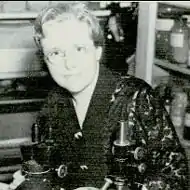Winona Hazel Welch
Winona Hazel Welch (May 5, 1896 – January 16, 1990) was an American bryologist. As a professor at DePauw University, she became the first female head of the botany and bacteriology department at DePauw University in Greencastle, Indiana.

Early life
Welch was born on May 5, 1896 in Goodland, Indiana to parents Charles A. and Carrie Johnson Welch.[1] Prior to her birth, her grandfather immigrated to America from England and bought land in Indiana prior to the American Civil War. After his death, some of his mementos were donated to the Indiana State Museum.[2] Welch was educated in a one-room school and her family discouraged thoughts of pursuing higher learning due to her gender.[3] However, she earned money through teaching at public schools during World War I and was able to afford tuition at DePauw University for four years.[4]
Education and career
Upon her arrival at DePauw (DPU), Welch attempted to pursue chemistry but was rejected by William Blanchard based on her gender.[2] As a result, she turned to study botany under the guidance of department head Truman G. Yuncker.[3] Yuncker encouraged her to pursue graduate school after her undergraduate degree, and she subsequently earned her Master's degree at the University of Illinois studying plant taxonomy and ecology with W. B. McDougall and William Trelease.[2] By 1928, she earned a PhD from Indiana University,[4] where she stayed as an instructor until being offered a position at DPU as an assistant professor of botany.[5] Welch was eventually promoted to Chairman of the botany department[6] and earned a grant from the American Philosophical Society to study in Europe for a year.[7] By 1940, she was elected secretary of the Indiana Academy of Science[8] and promoted to Full professor.[3]
As a result of her scientific success, Welch became the first female president of the Indiana Academy of Science in 1947.[9] Upon Yuncker's retirement in 1956, Welch was selected as the new department head of Botany and Bacteriology.[10] During her time as head, Welch published a comprehensive manual of moss in Indiana, titled "Mosses of Indiana."[11] She retired in 1961 as Professor Emeritus[1] and then served as curator of the Truman G. Yuncker Herbarium.[12] In 1964, she became the inaugural winner of the Outstanding Woman Teacher award at DPU.[13]
The standard author abbreviation W.H.Welch is used to indicate this person as the author when citing a botanical name.[14]
In 1987, a new moss species was named in her honor, Fontinalis welchiana.[15] She died on January 16, 1990.[16]
References
- "WELCH, WINONA HAZEL: 1896-". dlib.indiana.edu. Retrieved January 21, 2020.
- Goode, Jeanne (1988). "Winona: A Biographical Essay". Brittonia. New York Botanical Garden Press. 40 (2): 117–128. doi:10.1007/BF02807785. JSTOR 2806997. S2CID 43141826.
- Duane Isely (2002). One Hundred and One Botanists. Purdue University Press. pp. 340–343. ISBN 9781557532831. Retrieved January 21, 2020.
- "Winona H. Welch Papers (PP)". nybg.org. Retrieved January 21, 2020.
- "DePaw Grads on Faculty". Greencastle Daily Banner. Indiana. June 14, 1930.

- "Personal and local news". Greencastle Daily Banner. Indiana. May 12, 1939.

- "AAUW to hold final meeting". Greencastle Daily Banner. Indiana. April 19, 1940.

- "DPU Faculty Notes". Greencastle Daily Banner. Indiana. December 23, 1940. p. 3.

- "Dr. Welch heads state scientists". Greencastle Daily Banner. Indiana. October 21, 1947.

- "Three chosen as new dept. heads at DPU". Greencastle Daily Banner. Indiana. March 14, 1956.

- "Writes Manual on State Mosses". Greencastle Daily Banner. Indiana. August 10, 1957.

- "Two Distinguished Botanists". library.depauw.edu. Retrieved January 21, 2020.
- "Winona Welch, others honored by DPU Women". Greencastle Daily Banner. Indiana. April 17, 1964.

- IPNI. W.H.Welch.
- "Winona Hazel Welch, Moss Champion". esa.org. March 21, 2017. Retrieved January 21, 2020.
- Davies, Rosemary (May 1990). "News and Notes". Taxon. 39 (2): 374. JSTOR 1223080.